Excel XP -
Creating Complex Formulas

Excel XP
Creating Complex Formulas


/en/excelxp/creating-simple-formulas/content/
Simple formulas have one mathematical operation. Complex formulas involve more than one mathematical operation.
The order of mathematical operations is important. If you enter a formula that contains several operations—like adding, subtracting, and dividing—Excel XP knows to work these operations in a specific order. The order of operations is:
Using this order, let us see how the formula 120/(8-5)*4-2 is calculated in the following picture:

Let's take a look at another example:
2*(6-4) =?
Is the answer 8 or 4? If you ignored the parentheses and calculated in the order in which the numbers appear, 2*6-4, you'd get the wrong answer, 8. You must follow the order of operations to get the correct answer.
When using formulas with cell references, the results change each time the numbers are edited.
In Excel, never do math in your head and type the answer in a cell where you would expect to have a formula calculate the answer.
Before moving on, let's explore some more formulas to make sure you understand the order of operations by which Excel calculates an answer.
| 5*3/2 | Multiply 5*3 before performing the division operation because the multiplication sign comes before the division sign. The answer is 7.5. |
| 5/3*2 | Divide 5/3 before performing the multiplication operation because the division sign comes before the multiplication sign. The answer is 3.333333. |
| 5/(3*2) | Perform the operation in parentheses (3*2) first and divide 5 by this result. The answer is 0.833333. |
| 5+3-2 | Add 5+3 before performing the subtraction operation because the addition sign comes before the subtraction sign. The answer is 6. |
| 5-2+3 | Subtract 5-2 before performing the addition operation because the subtaction sign comes before the addition sign. The answer is 6. |
| 5-2*3 | Multiply 2*3 before performing the subtraction operation because the multiplication sign is of a higher order than the subtraction sign. The answer is -1. |
| (5-2)*3 | Perform the operation in parenthesis (5-2) first and then multiply by 3. The answer is 9. |
Excel XP automatically follows a standard order of operations in a complex formula. If you want a certain portion of the formula to be calculated first, put it in parentheses.
If we wanted to add the contents of cell B2 and cell B3, for example, then take that answer and multiply it by the data in cell A4, we would need to define the following formula: =(B2+B3)*A4.

Try changing one of the values in the formula and watch the answer to the formula change.
Excel will not always tell you if your formula contains an error, so it's up to you to check all of your formulas. To learn how to do this, read the Double-Check Your Formulas lesson from our Excel Formulas tutorial.
Sometimes you'll write a formula that gets used various places within a worksheet. For example, a spreadsheet may contain several columns of numbers. Each column will contain a formula that adds all of the numbers in it. You could write the formula several times, once in each column, or you could copy and paste it into each column. The fill formula method allows you to copy a formula and fill it into many different cells at the same time.
The mouse pointer changes to a black crosshair when passed over the fill handle, or the square box in the lower-right corner of the cell.

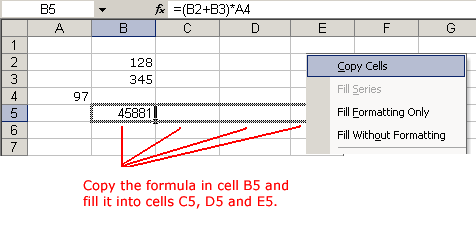
The cell references in a formula are automatically updated when the formula is copied to other cells in the spreadsheet.
You can also copy and paste formulas to other cells. This is discussed on the next page.
The process to copy and paste a formula is identical to the process for copying and pasting text.
 Copy button. Marching ants appear around the copied cell(s).
Copy button. Marching ants appear around the copied cell(s).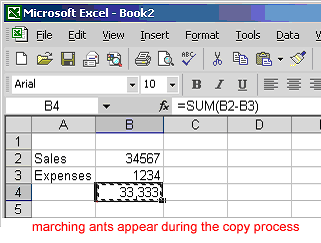
You can revise any formula that was previously written in a worksheet.
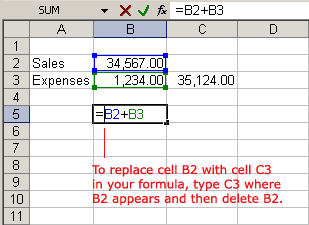
In earlier lessons, we saw how cell references in formulas automatically adjust to new locations when the formula is pasted into different cells.
Sometimes when you copy and paste a formula, you don't want one or more cell references to change. Absolute references solve this problem. Absolute cell references in a formula always refer to the same cell or cell range in a formula. If a formula is copied to a different location, the absolute reference remains the same.
An absolute reference is designated in the formula by the addition of a dollar sign ($). It can precede the column reference, the row reference, or both. Examples of absolute referencing include:
| $A$2 | The column and the row do not change when copied. |
| A$2 | The row does not change when copied. |
| $A2 | The column does not change when copied. |
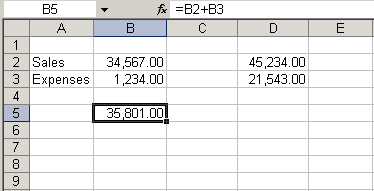
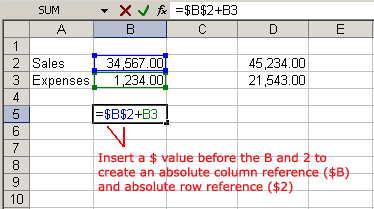
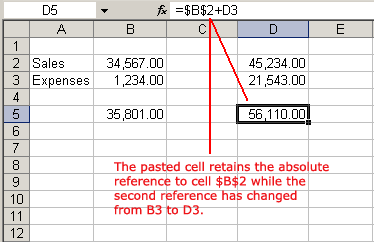
In cell A3, write a formula to add cell A1 and cell A2.
In cell A5, write a formula that divides cell A1 by the sum of cells A3, B3, and C3.
/en/excelxp/using-functions/content/